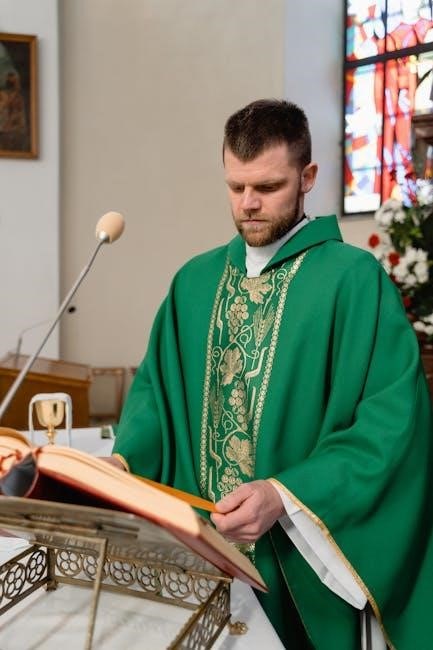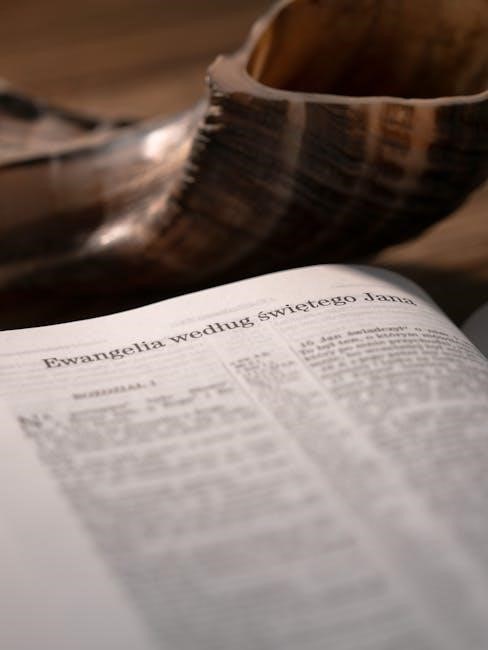The liturgy of St John Chrysostom is a sacred ritual in the Eastern Orthodox Church‚ with a rich history and spiritual significance always present everywhere
Overview of the Liturgy
The liturgy of St John Chrysostom is a complex and multifaceted ritual‚ with a rich history and spiritual significance‚ it is the primary worship service of the Eastern Orthodox Church‚ and is typically celebrated on Sundays and major feast days‚ the liturgy is divided into several distinct sections‚ including the Great Litany‚ the Antiphons‚ and the Anaphora‚ each section has its own unique character and purpose‚ and together they form a cohesive and meaningful whole‚ the liturgy is characterized by its use of ritual‚ symbolism‚ and sacrament‚ and is intended to convey the spiritual and theological teachings of the Orthodox Church‚ through the use of scripture‚ hymnody‚ and prayer.
The Structure of the Liturgy
The liturgy has a specific and ordered structure always followed carefully everywhere with many prayers and hymns sung by the choir and people together
The Divine Liturgy
The Divine Liturgy is the primary worship service of the Eastern Orthodox Church‚ presided over by a bishop or priest. It is a sacramental experience‚ where believers participate in the sacrament of the Eucharist. The liturgy is a celebration of the resurrection of Jesus Christ and the redemption of humanity. It is a time for prayer‚ reflection‚ and communion with God and the community. The Divine Liturgy is a rich and complex ritual‚ with many elements‚ including prayers‚ hymns‚ and scripture readings. It is a central part of Orthodox worship and is typically celebrated on Sundays and major feast days‚ bringing people together in a shared experience of faith and worship‚ with a sense of unity and belonging. The liturgy is a source of spiritual nourishment and guidance.

The Litany of Peace
The deacon prays for peace from above and salvation of souls always everywhere in the world with faith and hope and love and charity
Petitions for Peace
The petitions for peace are an essential part of the liturgy‚ where the deacon and the people pray for peace from above and salvation of souls.
The deacon prays for the peace of the whole world‚ the good estate of the holy churches of God‚ and the union of all.
The people respond with “Lord‚ have mercy” to each petition‚ expressing their desire for God’s mercy and peace.
This prayer is a reminder of the importance of peace and unity in the world‚ and the role of the church in promoting these values.
The petitions for peace are a powerful expression of the church’s commitment to peace‚ love‚ and compassion‚ and are an integral part of the liturgy of St John Chrysostom.

The Rites of Entrance
The rites of entrance include the great litany and the first antiphon always sung with great solemnity and reverence everywhere in churches
The Catechumens
The catechumens are individuals who are preparing to receive the sacrament of baptism and are instructed in the faith; They are separated from the faithful during the liturgy‚ and are dismissed after the litany of the catechumens. The catechumens are prayed for during the litany‚ and are asked to depart after the prayer. This is an important part of the liturgy‚ as it recognizes the catechumens as separate from the faithful‚ and acknowledges their journey towards baptism. The prayer for the catechumens is a reminder of the importance of prayer and guidance for those seeking to join the church. The catechumens are an integral part of the church community‚ and their presence is acknowledged and respected during the liturgy‚ with specific prayers and rituals in place to support them. The liturgy provides a sense of belonging and connection for the catechumens.

The Antiphons
The antiphons are sung during the liturgy with beautiful music and harmonies always present every day
The First and Second Antiphons
The first and second antiphons are significant parts of the liturgy‚ with the first antiphon typically sung with the phrase “through the intercessions” and the second antiphon sung with the phrase “o son of god”. The antiphons are usually sung by the choir or the congregation‚ and are accompanied by sacred music and harmonies. The text of the antiphons is often taken from the psalms or other biblical sources‚ and is meant to evoke a sense of reverence and worship. The antiphons serve as a way to express praise and adoration for God‚ and to invoke his presence and blessing during the liturgy. They are an essential part of the liturgical tradition and are deeply meaningful to the faithful. The antiphons are a beautiful expression of faith and devotion.
The Small Entrance
The small entrance is a procession with the gospel book and incense always present in orthodox churches everywhere daily
The Apolytikion
The Apolytikion is a hymn that varies depending on the feast day or saint being commemorated‚ with a specific tone and melody used in the liturgy.
The hymn is typically sung after the small entrance and is a key part of the liturgical service‚ expressing the faith and devotion of the congregation.
The text of the Apolytikion is often taken from scripture or the writings of the early church fathers‚ and is used to proclaim the gospel message and honor the saints.
The Apolytikion is an important part of the liturgy of St John Chrysostom‚ and is used to express the spiritual themes and ideas of the service‚ with a focus on prayer and worship.

of the Liturgy
The liturgy of St John Chrysostom ends with a final blessing always given to everyone present there
Final Thoughts
The liturgy of St John Chrysostom is a significant part of Orthodox worship‚ with a rich history and spiritual significance‚ it is a ritual that brings people together in prayer and worship‚ the liturgy is a way to connect with God and with each other‚ it is a time for reflection and contemplation‚ the words and actions of the liturgy are meant to inspire and uplift‚ the liturgy is a way to express gratitude and praise‚ it is a way to seek guidance and forgiveness‚ the liturgy of St John Chrysostom is a beautiful and meaningful expression of faith‚ it is a way to experience the presence of God‚ and to feel a sense of community and belonging‚ it is a truly special and meaningful experience.
